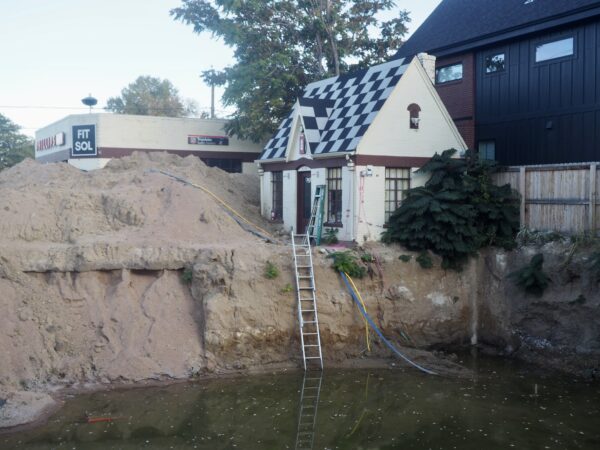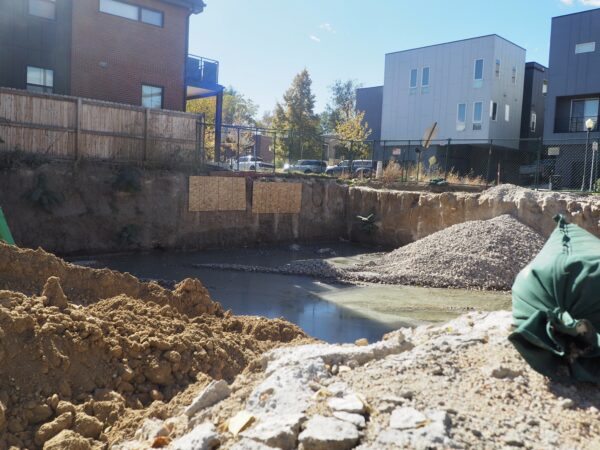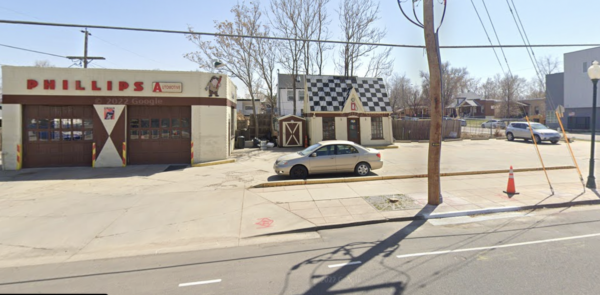
The development site at 44th and Zuni seen on Oct. 14. It has since been partially filled with rocks. (Matt Geiger/BusinessDen)
First-time developer Anthony Caselli got thrown in the deep end.
A CFO by day, Caselli is redeveloping two buildings and a parking lot into three new retail spaces and a gym on a 6,000-square-foot lot at the corner of West 44th Avenue and Zuni Street.
But when crews dug the foundation this summer, the hole filled with at least a foot of water.
“We just got a bad geotechnical report about groundwater so we had to stop and pause and figure it all out,” Caselli said.
Typically, geotechnical reports require drilling a hole, checking the water table and then reviewing the same hole a few days later to see if the water had risen, Caselli said, which often happens in Denver’s clay soil. He was told that there wasn’t water for at least 20 feet.
However, the engineer didn’t make that return visit to the site, likely leading to the misreading of the water table depth.
“This is really my first development,” he said. “I didn’t know enough to know what they were doing wrong until after the fact.”
The roughly 10-foot deep hole lasted from around late June until last week. Caselli said he’s filling it with 250 tons of rock up to the water line and will hopefully resume construction soon, pouring concrete footings and slabs overtop the rocks.

A view of the development site on Oct. 28. The hole is being filled with rocks. (Matt Geiger/BusinessDen)
“If you think of the aquifer, it’s not like it’s a hot tub or swimming pool down there where we go snorkel. It’s super saturated rock,” said Jeffrey L. Popiel, president of Denver geotech manufacturing firm Geotech Environmental Equipment Inc.
While not familiar with the specifics of 44th and Zuni, Popiel said the water may not be coming from an underground aquifer at all, but that it may be surface water from roofs, lawns and alleys draining into the ground.
“My sump runs in my house all the time, draining water out,” Popiel said, who lives in the Highlands neighborhood.
Ed Ford, who runs Complete Engineering Services and has been in the industry for nearly 40 years, stressed that the proper procedure for groundwater is to drill the hole and return to it later. He added that he’s doing a project near Caselli’s development, and said there are shallow, roughly 16-foot deep “perched” groundwater tables in the area.
“It doesn’t surprise me that there’s groundwater at that depth,” he said of Caselli’s site.
Caselli said the months-long delay in filling the hole was because he needed to study remedies. He explored “dewatering” it, hired a hydrologist to draft up some plans, but ultimately found that route to be a “complete nonstarter” because it was cost prohibitive.
“I wasn’t just going to refill the hole without a plan and risk doing it again,” he said.

The development site as seen in April 2022. The two buildings will be rehabbed into retail or restaurants, while the parking lot to the right – currently where the hole is – will be a restaurant. (Google Maps)
Caselli said he scraped drawings for a gym that was supposed to be beneath the new restaurant building; now there’s only room for eight-foot ceilings. He’s doing the development as a hobby project, but because of the mishap, Caselli said he’s lost “hundreds of thousands” but will continue construction for the neighborhood.
“I have done everything required to ensure the safety of the site and tried my best to expeditiously get back to building. I chose to do an adaptive reuse of these old buildings because I care about them and feel they are a part of the history of this community. I am paying a lot of money to keep them and had to fight the city to let me keep them,” Caselli said.
He purchased the land in 2021 for $875,000. The property includes an existing 260-square-foot office and 960-square-foot garage for a former Phillips Automotive. Caselli plans to restore these and turn them into retail and restaurant spaces, each with their own outdoor seating areas. The remainder of the property – originally a surface parking lot – will be developed into a 3,000-square-foot restaurant.
“This is not a project that will ultimately make me any money,” he said.

